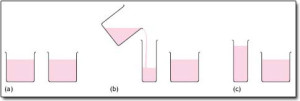Classification Errors: Preoperational children have difficulty understanding that an object can be classified in more than one way. For example, if shown three white buttons and four black buttons and asked whether there are more black buttons or buttons, the child is likely to respond that there are more black buttons. As the child’s vocabulary improves and more schemes are developed, the ability to classify objects improves.

Conservation of Liquid. Does pouring liquid in a tall, narrow container make it have more?
Conservation Errors: Conservation refers to the ability to recognize that moving or rearranging matter does not change the quantity. Imagine a 2 year old and a 4 year old eating lunch. The 4 year old has a whole peanut butter and jelly sandwich. He notices, however, that his younger sister’s sandwich is cut in half and protests, “She has more!” Watch the following examples of conversation errors of quantity and volume:
Theory of Mind
Imagine showing a child of three a bandaid box and asking the child what is in the box. Chances are, the child will reply, “bandaids.” Now imagine that you open the box and pour out crayons. If you ask the child what they thought was in the box before it was opened, they may respond, “crayons”. If you ask what a friend would have thought was in the box, the response would still be “crayons”. Why? Before about 4 years of age, a child does not recognize that the mind can hold ideas that are not accurate. So this 3 year old changes his or her response once shown that the box contains crayons. The theory of mind is the understanding that the mind can be tricked or that the mind is not always accurate. At around age 4, the child would reply, “Crayons” and understand that thoughts and realities do not always match.
This awareness of the existence of mind is part of social intelligence or the ability to recognize that others can think differently about situations. It helps us to be self-conscious or aware that others can think of us in different ways and it helps us to be able to be understanding or empathic toward others. This mind reading ability helps us to anticipate and predict the actions of others (even though these predictions are sometimes inaccurate).
The awareness of the mental states of others is important for communication and social skills. A child who demonstrates this skill is able to anticipate the needs of others. This video describes a research in which theory of mind is linked to popularity.
Language Development
Vocabulary growth: A child’s vocabulary expands between the ages of 2 to 6 from about 200 words to over 10,000 words through a process called fast-mapping. Words are easily learned by making connections between new words and concepts already known. The parts of speech that are learned depend on the language and what is emphasized. Children speaking verb-friendly languages such as Chinese and Japanese as well as those speaking English tend to learn nouns more readily. But those learning less verb-friendly languages such as English seem to need assistance in grammar to master the use of verbs (Imai, et als, 2008). Children are also very creative in creating their own words to use as labels such as a “take-care-of” when referring to John, the character on the cartoon, Garfield, who takes care of the cat.
Literal meanings: Children can repeat words and phrases after having heard them only once or twice. But they do not always understand the meaning of the words or phrases. This is especially true of expressions or figures of speech which are taken literally. For example, two preschool aged girls began to laugh loudly while listening to a tape-recording of Disney’s “Sleeping Beauty” when the narrator reports, “Prince Phillip lost his head!” They image his head popping off and rolling down the hill as he runs and searches for it. Or a classroom full of preschoolers hears the teacher say, “Wow! That was a piece of cake!” The children began asking “Cake? Where is my cake? I want cake!”
Overregularization: Children learn rules of grammar as they learn language but may apply these rules inappropriately at first. For instance, a child learns to ad “ed” to the end of a word to indicate past tense. Then form a sentence such as “I goed there. I doed that.” This is typical at ages 2 and 3. They will soon learn new words such as went and did to be used in those situations.
The Impact of Training: Remember Vygotsky and the Zone of Proximal Development? Children can be assisted in learning language by others who listen attentively, model more accurate pronunciations and encourage elaboration. The child exclaims, “I’m goed there!” and the adult responds, “You went there? Say, ‘I went there.’ Where did you go?” Children may be ripe for language as Chomsky suggests, but active participation in helping them learn is important for language development as well. The process of scaffolding is one in which the guide provides needed assistance to the child as a new skill is learned.
Private Speech: Do you ever talk to yourself? Why? Chances are, this occurs when you are struggling with a problem, trying to remember something, or feel very emotional about a situation. Children talk to themselves too. Piaget interpreted this as egocentric speech or a practice engaged in because of a child’s inability to seeing things from others points of views. Vygotsky, however, believed that children talk to themselves in order to solve problems or clarify thoughts. As children learn to think in words, they do so aloud before eventually closing their lips and engaging in private speech or inner speech. Thinking out loud eventually becomes thought accompanied by internal speech and talking to oneself becomes a practice only engaged in when we are trying to learn something or remember something, etc. This inner speech is not as elaborate as the speech we use when communicating with others (Vygotsky, 1962).



